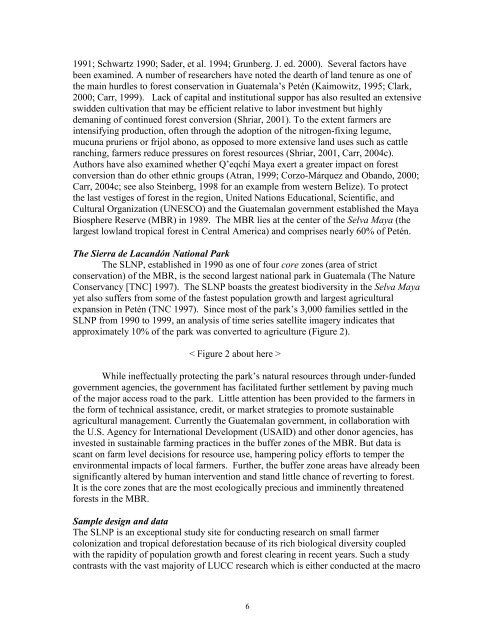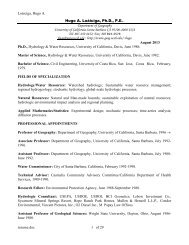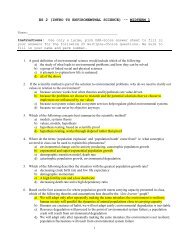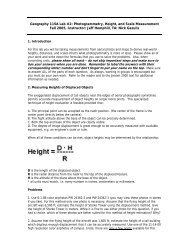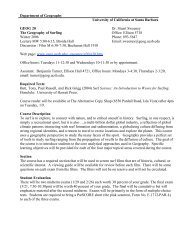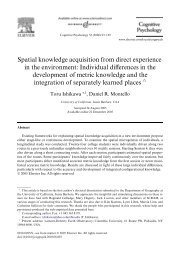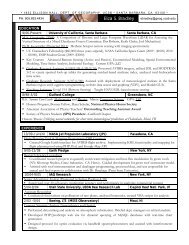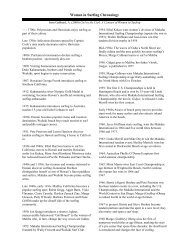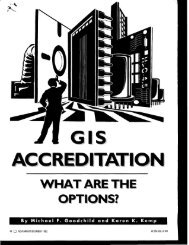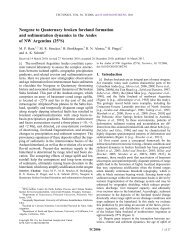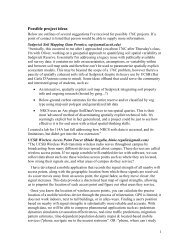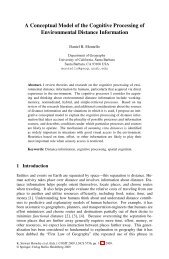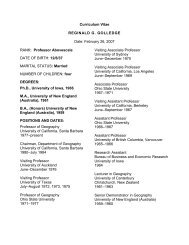Farm households and land use in a core conservation zone of the ...
Farm households and land use in a core conservation zone of the ...
Farm households and land use in a core conservation zone of the ...
You also want an ePaper? Increase the reach of your titles
YUMPU automatically turns print PDFs into web optimized ePapers that Google loves.
1991; Schwartz 1990; Sader, et al. 1994; Grunberg. J. ed. 2000). Several factors have<br />
been exam<strong>in</strong>ed. A number <strong>of</strong> researchers have noted <strong>the</strong> dearth <strong>of</strong> l<strong>and</strong> tenure as one <strong>of</strong><br />
<strong>the</strong> ma<strong>in</strong> hurdles to forest <strong>conservation</strong> <strong>in</strong> Guatemala’s Petén (Kaimowitz, 1995; Clark,<br />
2000; Carr, 1999). Lack <strong>of</strong> capital <strong>and</strong> <strong>in</strong>stitutional suppor has also resulted an extensive<br />
swidden cultivation that may be efficient relative to labor <strong>in</strong>vestment but highly<br />
deman<strong>in</strong>g <strong>of</strong> cont<strong>in</strong>ued forest conversion (Shriar, 2001). To <strong>the</strong> extent farmers are<br />
<strong>in</strong>tensify<strong>in</strong>g production, <strong>of</strong>ten through <strong>the</strong> adoption <strong>of</strong> <strong>the</strong> nitrogen-fix<strong>in</strong>g legume,<br />
mucuna pruriens or frijol abono, as opposed to more extensive l<strong>and</strong> <strong>use</strong>s such as cattle<br />
ranch<strong>in</strong>g, farmers reduce pressures on forest resources (Shriar, 2001, Carr, 2004c).<br />
Authors have also exam<strong>in</strong>ed whe<strong>the</strong>r Q’eqchí Maya exert a greater impact on forest<br />
conversion than do o<strong>the</strong>r ethnic groups (Atran, 1999; Corzo-Márquez <strong>and</strong> Ob<strong>and</strong>o, 2000;<br />
Carr, 2004c; see also Ste<strong>in</strong>berg, 1998 for an example from western Belize). To protect<br />
<strong>the</strong> last vestiges <strong>of</strong> forest <strong>in</strong> <strong>the</strong> region, United Nations Educational, Scientific, <strong>and</strong><br />
Cultural Organization (UNESCO) <strong>and</strong> <strong>the</strong> Guatemalan government established <strong>the</strong> Maya<br />
Biosphere Reserve (MBR) <strong>in</strong> 1989. The MBR lies at <strong>the</strong> center <strong>of</strong> <strong>the</strong> Selva Maya (<strong>the</strong><br />
largest lowl<strong>and</strong> tropical forest <strong>in</strong> Central America) <strong>and</strong> comprises nearly 60% <strong>of</strong> Petén.<br />
The Sierra de Lac<strong>and</strong>ón National Park<br />
The SLNP, established <strong>in</strong> 1990 as one <strong>of</strong> four <strong>core</strong> <strong>zone</strong>s (area <strong>of</strong> strict<br />
<strong>conservation</strong>) <strong>of</strong> <strong>the</strong> MBR, is <strong>the</strong> second largest national park <strong>in</strong> Guatemala (The Nature<br />
Conservancy [TNC] 1997). The SLNP boasts <strong>the</strong> greatest biodiversity <strong>in</strong> <strong>the</strong> Selva Maya<br />
yet also suffers from some <strong>of</strong> <strong>the</strong> fastest population growth <strong>and</strong> largest agricultural<br />
expansion <strong>in</strong> Petén (TNC 1997). S<strong>in</strong>ce most <strong>of</strong> <strong>the</strong> park’s 3,000 families settled <strong>in</strong> <strong>the</strong><br />
SLNP from 1990 to 1999, an analysis <strong>of</strong> time series satellite imagery <strong>in</strong>dicates that<br />
approximately 10% <strong>of</strong> <strong>the</strong> park was converted to agriculture (Figure 2).<br />
< Figure 2 about here ><br />
While <strong>in</strong>effectually protect<strong>in</strong>g <strong>the</strong> park’s natural resources through under-funded<br />
government agencies, <strong>the</strong> government has facilitated fur<strong>the</strong>r settlement by pav<strong>in</strong>g much<br />
<strong>of</strong> <strong>the</strong> major access road to <strong>the</strong> park. Little attention has been provided to <strong>the</strong> farmers <strong>in</strong><br />
<strong>the</strong> form <strong>of</strong> technical assistance, credit, or market strategies to promote susta<strong>in</strong>able<br />
agricultural management. Currently <strong>the</strong> Guatemalan government, <strong>in</strong> collaboration with<br />
<strong>the</strong> U.S. Agency for International Development (USAID) <strong>and</strong> o<strong>the</strong>r donor agencies, has<br />
<strong>in</strong>vested <strong>in</strong> susta<strong>in</strong>able farm<strong>in</strong>g practices <strong>in</strong> <strong>the</strong> buffer <strong>zone</strong>s <strong>of</strong> <strong>the</strong> MBR. But data is<br />
scant on farm level decisions for resource <strong>use</strong>, hamper<strong>in</strong>g policy efforts to temper <strong>the</strong><br />
environmental impacts <strong>of</strong> local farmers. Fur<strong>the</strong>r, <strong>the</strong> buffer <strong>zone</strong> areas have already been<br />
significantly altered by human <strong>in</strong>tervention <strong>and</strong> st<strong>and</strong> little chance <strong>of</strong> revert<strong>in</strong>g to forest.<br />
It is <strong>the</strong> <strong>core</strong> <strong>zone</strong>s that are <strong>the</strong> most ecologically precious <strong>and</strong> imm<strong>in</strong>ently threatened<br />
forests <strong>in</strong> <strong>the</strong> MBR.<br />
Sample design <strong>and</strong> data<br />
The SLNP is an exceptional study site for conduct<strong>in</strong>g research on small farmer<br />
colonization <strong>and</strong> tropical deforestation beca<strong>use</strong> <strong>of</strong> its rich biological diversity coupled<br />
with <strong>the</strong> rapidity <strong>of</strong> population growth <strong>and</strong> forest clear<strong>in</strong>g <strong>in</strong> recent years. Such a study<br />
contrasts with <strong>the</strong> vast majority <strong>of</strong> LUCC research which is ei<strong>the</strong>r conducted at <strong>the</strong> macro<br />
6


